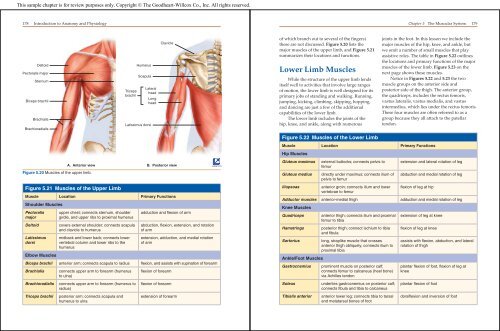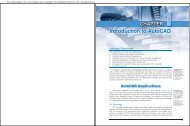You also want an ePaper? Increase the reach of your titles
YUMPU automatically turns print PDFs into web optimized ePapers that Google loves.
This sample chapter is for review purposes only. Copyright © The <strong>Goodheart</strong>-<strong>Willcox</strong> Co., Inc. All rights reserved.<br />
178 Introduction to Anatomy and Physiology<br />
Deltoid<br />
Pectoralis major<br />
Sternum<br />
Biceps brachii<br />
Brachialis<br />
Brachioradialis<br />
Figure 5.20 Muscles of the upper limb.<br />
Figure 5.21 Muscles of the Upper Limb<br />
Muscle Location Primary Functions<br />
Shoulder Muscles<br />
Pectoralis<br />
major<br />
upper chest; connects sternum, shoulder<br />
girdle, and upper ribs to proximal humerus<br />
Deltoid covers external shoulder; connects scapula<br />
and clavicle to humerus<br />
Latissimus<br />
dorsi<br />
Elbow Muscles<br />
midback and lower back; connects lower<br />
vertebral column and lower ribs to the<br />
humerus<br />
adduction and fl exion of arm<br />
abduction, fl exion, extension, and rotation<br />
of arm<br />
extension, adduction, and medial rotation<br />
of arm<br />
Biceps brachii anterior arm; connects scapula to radius fl exion, and assists with supination of forearm<br />
Brachialis connects upper arm to forearm (humerus<br />
to ulna)<br />
Brachioradialis connects upper arm to forearm (humerus to<br />
radius)<br />
Triceps brachii posterior arm; connects scapula and<br />
humerus to ulna<br />
Triceps<br />
brachii<br />
Humerus<br />
Scapula<br />
Latissimus dorsi<br />
Lateral<br />
head<br />
Long<br />
head<br />
Clavicle<br />
A. Anterior view B. Posterior view<br />
fl exion of forearm<br />
fl exion of forearm<br />
extension of forearm<br />
Label Art<br />
of which branch out to several of the fi ngers)<br />
these are not discussed. Figure 5.20 lists the<br />
major muscles of the upper limb, and Figure 5.21<br />
summarizes their locations and functions.<br />
Lower Limb Muscles<br />
While the structure of the upper limb lends<br />
itself well to activities that involve large ranges<br />
of motion, the lower limb is well designed for its<br />
primary jobs of standing and walking. Running,<br />
jumping, kicking, climbing, skipping, hopping,<br />
and dancing are just a few of the additional<br />
capabilities of the lower limb.<br />
The lower limb includes the joints of the<br />
hip, knee, and ankle, along with numerous<br />
Figure 5.22 Muscles of the Lower Limb<br />
Muscle Location Primary Functions<br />
Hip Muscles<br />
Gluteus maximus external buttocks; connects pelvis to<br />
femur<br />
Gluteus medius directly under maximus; connects ilium of<br />
pelvis to femur<br />
Iliopsoas anterior groin; connects ilium and lower<br />
vertebrae to femur<br />
<strong>Chapter</strong> 5 The Muscular System 179<br />
extension and lateral rotation of leg<br />
abduction and medial rotation of leg<br />
fl exion of leg at hip<br />
Adductor muscles anterior-medial thigh adduction and medial rotation of leg<br />
Knee Muscles<br />
Quadriceps anterior thigh; connects ilium and proximal<br />
femur to tibia<br />
Hamstrings posterior thigh; connect ischium to tibia<br />
and fi bula<br />
Sartorius long, straplike muscle that crosses<br />
anterior thigh obliquely; connects ilium to<br />
proximal tibia<br />
Ankle/Foot Muscles<br />
Gastrocnemius prominent muscle on posterior calf;<br />
connects femur to calcaneus (heel bone)<br />
via Achilles tendon<br />
Soleus underlies gastrocnemius on posterior calf;<br />
connects fi bula and tibia to calcaneus<br />
Tibialis anterior anterior lower leg; connects tibia to tarsal<br />
and metatarsal bones of foot<br />
joints in the foot. In this lesson we include the<br />
major muscles of the hip, knee, and ankle, but<br />
we omit a number of small muscles that play<br />
assistive roles. The table in Figure 5.22 outlines<br />
the locations and primary functions of the major<br />
muscles of the lower limb. Figure 5.23 on the<br />
next page shows these muscles.<br />
Notice in Figures 5.22 and 5.23 the two<br />
muscle groups on the anterior side and<br />
posterior side of the thigh. The anterior group,<br />
the quadriceps, includes the rectus femoris,<br />
vastus lateralis, vastus medialis, and vastus<br />
intermedius, which lies under the rectus femoris.<br />
These four muscles are often referred to as a<br />
group because they all attach to the patellar<br />
tendon.<br />
extension of leg at knee<br />
fl exion of leg at knee<br />
assists with fl exion, abduction, and lateral<br />
rotation of thigh<br />
plantar fl exion of foot, fl exion of leg at<br />
knee<br />
plantar fl exion of foot<br />
dorsifl exion and inversion of foot

















